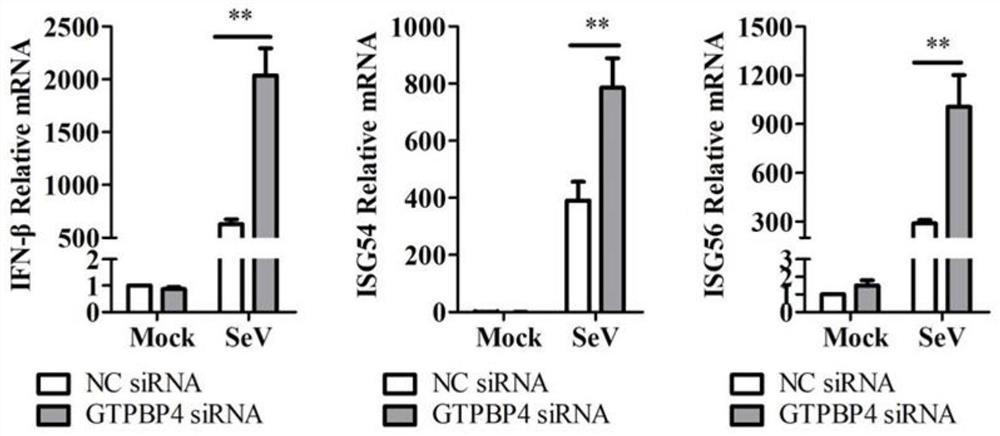Application of GTPBP4 protein as immunosuppressant and construction of knockdown or overexpression GTPBP4 cell line
An immunosuppressant and protein expression technology, applied to genetically modified cells, cells modified by introducing foreign genetic material, applications, etc., can solve problems such as unclear relationship between natural immunity, so as to promote vaccine production and increase virus titer Effect
- Summary
- Abstract
- Description
- Claims
- Application Information
AI Technical Summary
Problems solved by technology
Method used
Image
Examples
Embodiment 1
[0070] Example 1 Immunosuppressive effect of GTPBP4
[0071] 1. GTPBP4 inhibits SeV-induced activation of the IFN-β promoter
[0072] HEK-293T cells were plated in a single well of a 24-well plate, and when the cells reached 70%-80% confluence, NC siRNA (75nm / well) and GTPBP4 siRNA (75nm) were transfected with liposome reagents. / well), IFN-β promoter luciferase plasmid (IFN-β-luc, 100ng / well) and internal reference TK plasmid (10ng / well), transfected for 36h, inoculated with an appropriate amount of SeV, 12h after infection, harvested cells, The activity of the IFN-β promoter was measured using a luciferase assay kit.
[0073] The experimental results are as figure 1 shown that SeV-induced activity of the IFN-β promoter was significantly increased in cells transfected with GTPBP4 siRNA. The results showed that GTPBP4 inhibited the activity of SeV-induced IFN-β promoter, while the activity of SeV-induced IFN-β promoter was significantly increased after GTPBP4 siRNA interfer...
Embodiment 2
[0095] Example 2 Evaluation of the effect of down-regulating expression of GTPBP4 protein to inhibit Seneca virus replication
[0096] 1. Preparation of HEK-293T Cell Samples Infected with Seneca Virus
[0097] HEK-293T cells were plated in a single well of a 6-well plate. When the cells reached 70%-80% confluence, NC siRNA and GTPBP4 siRNA were transfected with liposome reagents for 36 h, inoculated with 1 MOI of Seneca virus, and then inoculated with maintenance medium for 1 h. Cells were harvested 12 h after infection.
[0098] 2. Detection of viral protein content
[0099] Preparation of protein samples: Discard the cell culture supernatant after 12h infection with Seneca virus, wash the cell samples with PBS once, scrape the cells with a cell spatula, transfer them into a 1.5mL centrifuge tube, centrifuge at 2000rpm for 5min, discard the supernatant , retain the cell pellet, which is the harvested cell sample (all operated on ice); add an appropriate amount of cell lys...
Embodiment 3
[0106] Example 3 Evaluation of the effect of GTPBP4 protein on promoting Seneca virus replication
[0107] 1. Preparation of HEK-293T Cell Samples Infected with Seneca Virus
[0108] Will 6x10 5 HEK-293T cells were plated in a single well of a 6-well plate. When the cells grow to 70%-80% confluence, 0, 1, and 2 μg of FLAG-GTPBP4 plasmids were transfected with liposome reagents, transfected for 24 hours, inoculated with 1MOI of Seneca virus, and then switched to maintenance after inoculation for 1 hour. liquid culture.
[0109] 2. Detection of viral protein content
[0110] The detection method is the same as that described in 2 of Example 2.
[0111] The experimental results are as Image 6 As shown in the middle and left figures, with the increase of the amount of FLAG-GTPBP4 plasmid added, the expression of Seneca virus VP1 protein was significantly increased, indicating that compared with normal HEK-293T cells, exogenous addition of GTPBP4 protein significantly promote...
PUM
 Login to View More
Login to View More Abstract
Description
Claims
Application Information
 Login to View More
Login to View More - R&D
- Intellectual Property
- Life Sciences
- Materials
- Tech Scout
- Unparalleled Data Quality
- Higher Quality Content
- 60% Fewer Hallucinations
Browse by: Latest US Patents, China's latest patents, Technical Efficacy Thesaurus, Application Domain, Technology Topic, Popular Technical Reports.
© 2025 PatSnap. All rights reserved.Legal|Privacy policy|Modern Slavery Act Transparency Statement|Sitemap|About US| Contact US: help@patsnap.com



